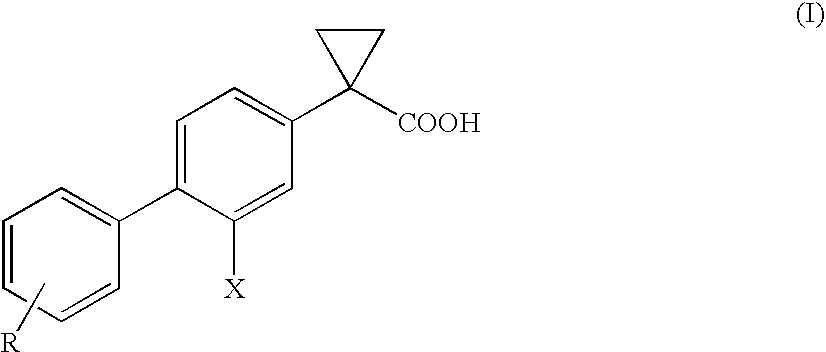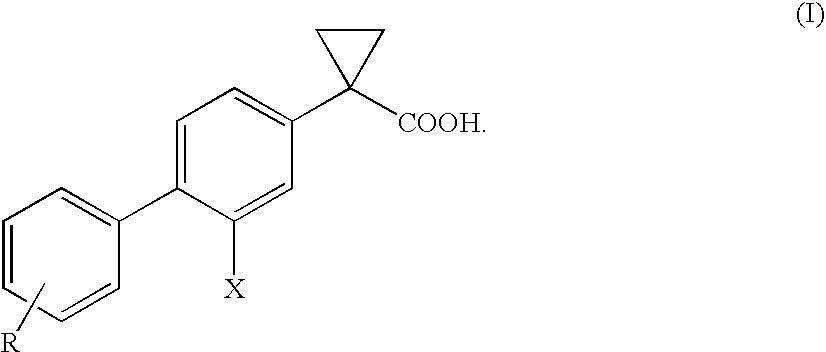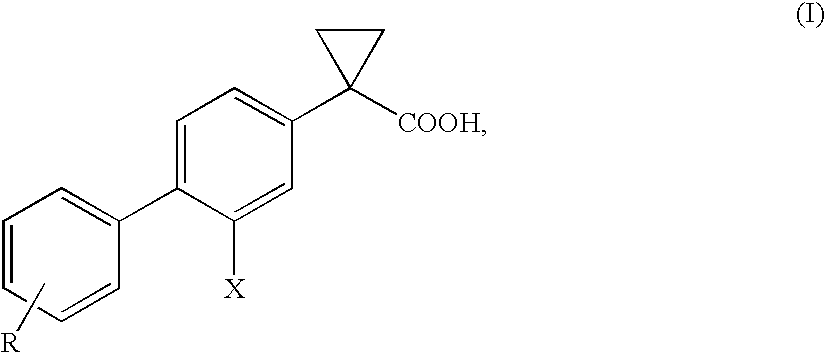Process of preparing derivatives of 1-(2-halobiphenyl-4-yl)-cyclopropanecarboxylic acid
a technology of cyclopropanecarboxylic acid and process, which is applied in the field of compound preparation, can solve the problems of low overall yield (12-14%), severe industrial use restrictions, and detrimental to its yield, and achieves high chemical purity, high yield, and high efficiency
- Summary
- Abstract
- Description
- Claims
- Application Information
AI Technical Summary
Benefits of technology
Problems solved by technology
Method used
Image
Examples
example 1
Preparation of 3′,4′-dichloro-2-fluoro-4-methyl-biphenyl
[0086]3-fluoro-4-bromotoluene (50 g, 0.265 mol) and 3,4-dichlorophenylboronic acid (53 g, 0.278 mol) were dissolved in ethanol (970 ml) and sodium carbonate ( 56.1 g, 0.529 mol) was added. Palladium 10% on charcoal (6.6 g) was added, and the mixture was refluxed for 4 hours under nitrogen atmosphere. The reaction mixture was cooled, filtered and concentrated, isopropyl acetate (250 ml) was added, and then the solution was concentrated again. The residue was dissolved in isopropyl acetate (250 ml) and 1M sodium hydroxide (250 ml). The organic phase was separated, washed with water (125 ml), neutralized with hydrogen chloride 3 M, washed with brine (250 ml), and concentrated. The residue was mixed with acetonitrile / water 1 / 1 v / v (150 ml), heated to 40° C. to dissolve and then cooled to 0 to 5° C., and stirred for 30 minutes at this temperature. The compound 3′,4′-dichloro-2-fluoro-4-methyl-biphenyl crystallized as a powder.[0087]...
example 2
Preparation of 3′,4′-dichloro-2-fluoro-4-bromomethyl-biphenyl
[0090]3′,4′-dichloro-2-fluoro-4-methyl-biphenyl (29 g, 0.114 mol), N-bromosuccinimide (21.2 g, 0.119 mol), benzoyl peroxide (1.4 g, 0.004 mol) were dissolved in acetonitrile (190 ml). The mixture was refluxed for 3 hours, then cooled, mixed with a solution of sodium sulphite (2.2 g) in water (54 ml), stirred for 30 minutes and then allowed to rest to separate the phases. The lower aqueous phase was separated and extracted with dichloromethane (29 ml). The upper phase was concentrated under vacuum, mixed with water (10 ml), and dichloromethane (58 ml) and stirred. The organic phases were separated and put together, washed twice with water (29 ml), and concentrated under vacuum. The compound 3′,4′-dichloro-2-fluoro-4-bromomethyl-biphenyl was isolated as an orange oil (35.7 g, 94% yield).
[0091]HPLC-UV purity (250 nm): 77.1%
[0092]1H NMR (DMSO-d6, 300 MHz): 7.87-7.12 (m, 6H); 4.76 (s, 2H)
example 3
Preparation of 3′,4′-dichloro-2-fluoro-4-cyanomethyl-biphenyl
[0093]3′,4′-dichloro-2-fluoro-4-bromomethyl-biphenyl (35.0 g, 0.105 mol) and sodium cyanide (5.4 g, 0.110 mol) were dissolved in a mixture of ethanol (228 ml) and water (25 ml), then heated at 50° C. for 3 hours. The solution was concentrated under vacuum and the residue was suspended in ethanol / water 1 / 1 v / v (35 ml) and cooled at 0-5° C. for 30 minutes. The obtained solid is filtered and dried at 40° C. under vacuum. The crude product was suspended in ethanol (56 ml) at 20 to 25° C. for 30 minutes, filtered and dried at 40° C. under vacuum. The compound 3′,4′-dichloro-2-fluoro-4-cyanomethyl-biphenyl was obtained as a light brown powder (16.8 g, 57% yield).
[0094]HPLC-UV purity (250 nm): 92.3%.
[0095]1H NMR (DMSO-d6, 300 MHz): 7.78 (m, 2H); 7.60 (m, 2H); 7.34 (m, 2H); 4.14 (s, 1H)
PUM
| Property | Measurement | Unit |
|---|---|---|
| temperature | aaaaa | aaaaa |
| temperature | aaaaa | aaaaa |
| temperature | aaaaa | aaaaa |
Abstract
Description
Claims
Application Information
 Login to View More
Login to View More - R&D
- Intellectual Property
- Life Sciences
- Materials
- Tech Scout
- Unparalleled Data Quality
- Higher Quality Content
- 60% Fewer Hallucinations
Browse by: Latest US Patents, China's latest patents, Technical Efficacy Thesaurus, Application Domain, Technology Topic, Popular Technical Reports.
© 2025 PatSnap. All rights reserved.Legal|Privacy policy|Modern Slavery Act Transparency Statement|Sitemap|About US| Contact US: help@patsnap.com



